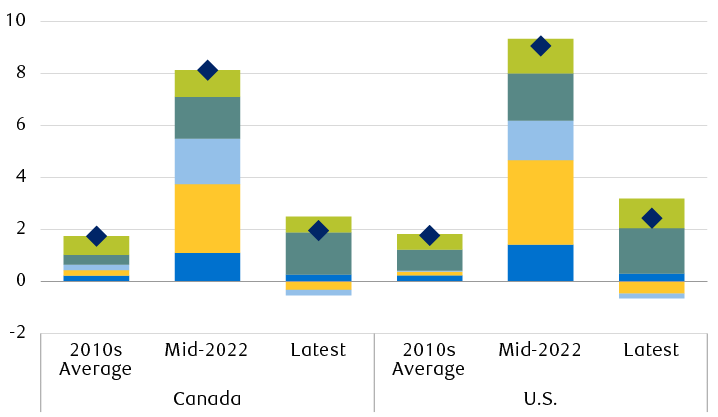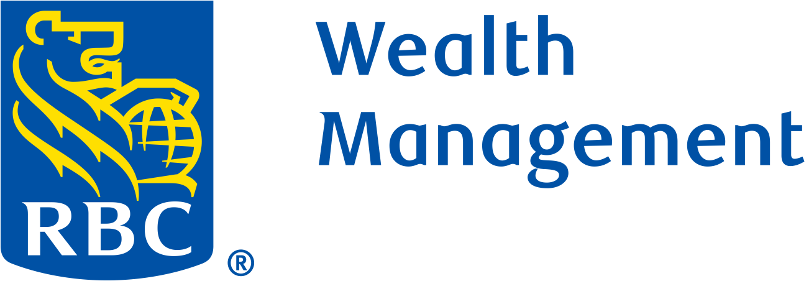Mission (not quite) accomplished
Central banks have made considerable progress reining in inflation, helped by healing supply chains and lower commodity prices. Headline inflation is below 2.5 percent in the U.S., UK, and eurozone, while the Bank of Canada (BoC) managed to hit its two percent target in August for the first time in 3.5 years. Policymakers are now shifting their focus to growth and labour markets, aiming to stick the soft landing.
But investors won’t see central bankers unfurling a “mission accomplished” banner on inflation just yet. There are still pockets of price pressure—most significantly in housing and other services—that we think are cause for concern, and upside risks to inflation remain. There are also several structural forces that could keep inflation on the high side of two percent over the medium term, unlike throughout the 2010s when inflation tended to fall short of central banks’ targets.
Inflation is down from its mid-2022 peak thanks to lower goods prices
Contributions to year-over-year Consumer Price Index (CPI) inflation (percentage points)

The column chart shows year-over-year Consumer Price Index (CPI) inflation for the U.S. and Canada, broken down into categories of food, shelter, energy, services not including shelter, and core goods. The average for the 2010s, in mid-2022, and currently. Average inflation in the 2010s was below 2% in both countries. Inflation was highest in mid-2022, at roughly 9.1% in the U.S. and 8.1% in Canada. The latest inflation readings are roughly 2.4% in the U.S. and 1.9% in Canada.
Source - RBC Wealth Management, Statistics Canada, U.S. Bureau of Labor Statistics
The good(s), the bad, and the ugly
The dramatic inflation slowdown from its mid-2022 cycle high has been concentrated in goods prices. Energy price growth has normalized after the combination of war in Europe and a post-pandemic travel resurgence exerted significant upward pressure in 2022. The supply chain issues and unusually high demand that drove food and core (non-food and energy) goods prices higher have since eased. Central banks can take some credit for tight monetary policy reducing demand for goods, but factors outside their control were also key to reining in inflation.
Services prices haven’t normalized to the same extent. Non-shelter services inflation, which is thought to be a good barometer of domestically generated price pressures, has come down from cycle highs but remains elevated relative to pre-pandemic levels, particularly in the United States. Despite a cooling labour market, U.S. wage growth remains firm and has, in fact, accelerated slightly in recent months. However, strong pay gains appear to be justified by the U.S. economy’s robust productivity growth. That’s not the case in Canada, where productivity has been sluggish and growth in unit labour costs remains too high for the BoC’s comfort.
Policymakers are hoping that rising unemployment will reduce labour cost pressures going forward. But recent labour disruptions and large wage settlements on both sides of the border show that workers looking to play catch-up after a period of high inflation can keep wage growth sticky.
Shelter inflation is another source of ongoing price pressure thanks to tight rental and housing markets. In the U.S., rent and owner’s equivalent rent (what a homeowner could charge to rent out their home) lagged rising market rents and home prices during the pandemic, and haven’t slowed as quickly as was previously hoped. In Canada, still-rising rents, and higher mortgage interest costs (not a direct component of the U.S. Consumer Price Index [CPI]) are keeping upward pressure on shelter inflation. Slower immigration on both sides of the border might help alleviate some rental market pressure, but historically low vacancy rates could make a return to pre-pandemic shelter inflation protracted or even elusive.
Second wave vibes?
While central banks deal with these lingering price pressures in services, they must also be cognizant of upside risks in goods prices. Oil prices are no higher than they were a year ago, prior to the breakout of the Israel-Hamas war, but spiked higher recently amid concerns about broadening conflict in the region. Russia’s invasion of Ukraine was a key contributor to rising energy prices and peak inflation in 2022, and geopolitical tensions remain a key risk to inflation, even if energy is a non-factor in current CPI readings.
Many comparisons have been made between the current cycle and the dual waves of inflation seen during the 1970s. While we think such comparisons are overblown, it’s worth remembering that geopolitics and oil prices were key drivers of that second wave of inflation in the 1970s.
Trade policy is another inflation key topic ahead of the U.S. election. Neither political party has been a strong booster of free trade recently, but as we noted in a recent article, Donald Trump has said he favours doubling down on protectionist policies. His proposal for across-the-board tariffs of 10 percent or more on all imports and high tariffs of 50 percent or more on Chinese imports could add 0.8 percentage points to domestic inflation, according to an RBC Global Asset Management analysis that we recently discussed. Even if those policies are only partially implemented, higher tariffs could be an unwelcome inflation headache for the Fed.
Beyond these near-term risks, there are a number of structural factors that could exert upward pressure on inflation in the medium to long term:
- The key concern around rising U.S. government debt levels is not default but inflation. High levels of government spending put upward pressure on prices, and high debt loads encourage governments to inflate away the value of existing debt.
- The aforementioned tariff threats are part of a broader deglobalization trend that could put upward pressure on goods prices after two decades of globalization-capped core goods inflation.
- Cyclically tight labour markets have put upward pressure on wages, and there could be a structural element as retiring baby boomers limit labour supply growth.
None of these factors will necessarily act as an acute price shock, but they could cause inflation to err on the high side of central banks’ targets over time.
Managing inflation in portfolios
There are downside risks to inflation as well from slow growth in China (a key source of commodities demand) and lingering recession concerns in G7 economies. Structural pressures and upside risks don’t preclude inflation temporarily undershooting central banks’ targets. And while we’re not suggesting investors will necessarily face another wave of inflation like the one that emerged in 2022, when both equities and bonds sold off sharply, we think expecting a sustained return to the low-inflation environment of the 2010s would be too complacent.
So how should investors factor inflation risks into their asset allocation decisions? We think the effect of inflation on fixed income is well-known, with rising consumer prices reducing real returns. Bond buyers can protect against that risk with inflation-indexed bonds. Breakeven inflation—the rate of inflation above which an inflation-indexed bond will outperform its nominal counterpart—has declined alongside CPI, providing a cheaper inflation hedge. But poor liquidity (particularly in Canada) and potential tax headaches associated with inflation-indexed bonds can be off-putting for some investors.
Equities can provide a better inflation hedge, giving investors a claim on a growing nominal earnings stream. But as we saw in 2022, that effect can be offset when the antidote to high inflation—tighter monetary policy—is expected to slow the economy and reduce future earnings. Real assets such as real estate, commodities, and gold tend to outperform in periods of rising inflation, but we think the broader macro backdrop will also influence their returns.

